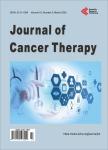Synthesis of Gemcitabine-(C<sub>4</sub>-<i>amide</i>)-[anti-HER2/<i>neu</i>] Utilizing a UV-Photoactivated Gemcitabine Intermediate: Cytotoxic Anti-Neoplastic Activity against Chemotherapeutic-Resistant Mammary Adenocarcinoma SKBr-3
Synthesis of Gemcitabine-(C<sub>4</sub>-<i>amide</i>)-[anti-HER2/<i>neu</i>] Utilizing a UV-Photoactivated Gemcitabine Intermediate: Cytotoxic Anti-Neoplastic Activity against Chemotherapeutic-Resistant Mammary Adenocarcinoma SKBr-3作者机构:Department of Basic Sciences College of Veterinary Medicine Mississippi State University Oktibbeha County USA Wise Center Mississippi State University Oktibbeha County USA
出 版 物:《Journal of Cancer Therapy》 (癌症治疗(英文))
年 卷 期:2012年第3卷第5期
页 面:689-711页
学科分类:1002[医学-临床医学] 100214[医学-肿瘤学] 10[医学]
主 题:Gemcitabine HER2/neu UV-Photoactivated Gemcitabine-(C4-amide) Intermediate Organic Chemistry Reaction Gemcitabine-(C4-amide)-[anti-HER2/neu] Covalent Bond Synthesis Gemcitabine (C5- methylcarbamate)-[anti-HER2/neu] Cytotoxic Anti-Neoplastic Potency Chemotherapeutic-Resistant Mammary Adenocarcinoma Cell-ELISA SDS-PAGE Immunodetection Chemiluminescent Autoradiography
摘 要:Gemcitabine is a pyrimidine nucleoside analog that becomes triphosphorylated intracellularly where it competitively inhibits cytidine incorporation into DNA strands. Another mechanism-of-action of gemcitabine (diphosphorylated form) involves irreversible inhibition of the enzyme ribonucleotide reductase thereby preventing deoxyribonucleotide synthesis. Functioning as a potent chemotherapeutic gemcitabine promote decreases in neoplastic cell proliferation and apoptosis which is frequently found to be effective for the treatment of several leukemias and a wide spectrum of carcinomas. A brief plasma half-life in part due to rapid deamination and chemotherapeutic-resistance restricts the utility of gemcitabine in clinical oncology. Selective “targeted delivery of gemcitabine represents a potential molecular strategy for simultaneously prolonging its plasma half-life and minimizing innocient tissues and organ systems exposure to chemotherapy. The molecular design and an organic chemistry based synthesis reaction is described that initially generates a UV-photoactivated gemcitabine intermediate. In a subsequent phase of the synthesis method the UV-photoactivated gemcitabine intermediate is covalently bonded to a monoclonal immunoglobulin yielding an end-product in the form of gemcitabine-(C4-amide)-[anti-HER2/neu]. Analysis by SDS-PAGE/chemiluminescent auto-radiography did not detect evidence of gemcitabine-(C4-amide)-[anti-HER2/neu] polymerization or degradative fragmentation while cell-ELISA demonstrated retained binding-avidity for HER2/neu trophic membrane receptor complexes highly over-expressed by chemotherapeutic-resistant mammary adenocarcinoma (SKBr-3). Compared to chemotherapeutic-resistant mammary adenocarcinoma (SKBr-3), the covalent immunochemotherapeutic, gemcitabine-(C4-amide)-[anti-HER2/neu] is anticipated to exert greater levels of cytotoxic anti-neoplastic potency against other neoplastic cell types like pancreatic carcinoma, small-cell lung carcinoma,



